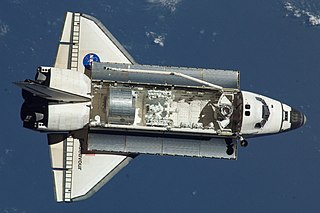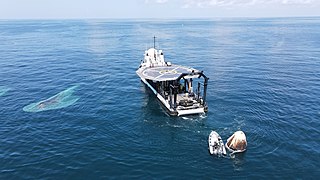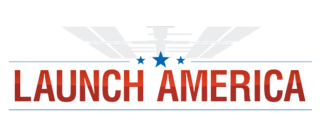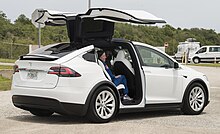
Space Shuttle Endeavour is a retired orbiter from NASA's Space Shuttle program and the fifth and final operational Shuttle built. It embarked on its first mission, STS-49, in May 1992 and its 25th and final mission, STS-134, in May 2011. STS-134 was expected to be the final mission of the Space Shuttle program, but with the authorization of STS-135 by the United States Congress, Atlantis became the last shuttle to fly.

The Space Shuttle program was the fourth human spaceflight program carried out by the U.S. National Aeronautics and Space Administration (NASA), which accomplished routine transportation for Earth-to-orbit crew and cargo from 1981 to 2011. Its official name, Space Transportation System (STS), was taken from a 1969 plan for a system of reusable spacecraft of which it was the only item funded for development. It flew 135 missions and carried 355 astronauts from 16 countries, many on multiple trips.

Robert Shane Kimbrough is a retired United States Army officer and NASA astronaut. He was part of the first group of candidates selected for NASA astronaut training following the Space Shuttle Columbia disaster. Kimbrough is a veteran of three spaceflights, the first being a Space Shuttle flight, and the second being a six-month mission to the ISS on board a Russian Soyuz craft. He was the commander of the International Space Station for Expedition 50, and returned to Earth in April 2017. He is married to the former Robbie Lynn Nickels.

Soichi Noguchi is a Japanese aeronautical engineer and former JAXA astronaut. His first spaceflight was as a mission specialist aboard STS-114 on 26 July 2005 for NASA's first "return to flight" Space Shuttle mission after the Columbia disaster. He was also in space as part of the Soyuz TMA-17 crew and Expedition 22 to the International Space Station (ISS), returning to Earth on 2 June 2010. He is the sixth Japanese astronaut to fly in space, the fifth to fly on the Space Shuttle, and the first to fly on Crew Dragon.

Shannon Walker is an American physicist and a NASA astronaut selected in 2004. She launched on her first mission into space on June 25, 2010, onboard Soyuz TMA-19 and spent over 163 days in space.

Akihiko Hoshide is a Japanese engineer, JAXA astronaut, and former commander of the International Space Station. On August 30, 2012, Hoshide became the third Japanese astronaut to walk in space.

Robert Louis Behnken is an American engineer, a former NASA astronaut, and former Chief of the Astronaut Office.

Douglas Gerald Hurley is an American engineer, former Marine Corps pilot and former NASA astronaut. He piloted Space Shuttle missions STS-127 and STS-135, the final flight of the Space Shuttle program. He launched into space for the third time as commander of Crew Dragon Demo-2, the first crewed spaceflight from American soil since STS-135 and became, together with Bob Behnken, the first astronaut in history launching aboard a commercial orbital spacecraft. He was also the first Marine to fly the F/A-18 E/F Super Hornet. His call sign is "Chunky", and he was sometimes referred to by this name on the communication loops.

NASA Astronaut Group 16 was a group of 44 astronauts announced by NASA on May 1, 1996. The class was nicknamed "The Sardines" for being such a large class, humorously implying that their training sessions would be as tightly packed as sardines in a can. These 44 candidates compose the largest astronaut class to date. NASA selected so many candidates in preparation for the anticipated need for ISS crew members, along with regular shuttle needs. Nine of the 44 astronauts selected were from other countries including 5 from Europe and 2 from Canada and Japan.

Thomas Gautier Pesquet is a French aerospace engineer, pilot, European Space Agency astronaut, actor and writer. Pesquet was selected by ESA as a candidate in May 2009, and he successfully completed his basic training in November 2010. From November 2016 to June 2017, Pesquet was part of Expedition 50 and Expedition 51 as a flight engineer. Pesquet returned to space in April 2021 on board the SpaceX Crew Dragon for a second six-month stay on the ISS.

Dragon 2 is a class of partially reusable spacecraft developed, manufactured, and operated by American space company SpaceX, primarily for flights to the International Space Station (ISS). SpaceX also launches private missions, such as Inspiration4 and Axiom Space Missions. There are two variants of the Dragon spacecraft: Crew Dragon, a spacecraft capable of ferrying four crewmembers, and Cargo Dragon, a replacement for the original Dragon 1 used to carry freight to and from space. The spacecraft consists of a reusable space capsule and an expendable trunk module. The spacecraft launches atop a Falcon 9 Block 5 rocket and the capsule returns to Earth through splashdown.

Crew Dragon Demo-2 was the first crewed test flight of the Crew Dragon spacecraft. The spacecraft, named Endeavour, launched on 30 May 2020 on a Falcon 9 rocket, and carried NASA astronauts Douglas Hurley and Robert Behnken to the International Space Station in the first crewed orbital spaceflight launched from the United States since the final Space Shuttle mission in 2011, and the first ever operated by a commercial provider. Demo-2 was also the first two-person orbital spaceflight launched from the United States since STS-4 in 1982. Demo-2 completed the validation of crewed spaceflight operations using SpaceX hardware and received human-rating certification for the spacecraft, including astronaut testing of Crew Dragon capabilities on orbit.

Expedition 61 was the 61st Expedition to the International Space Station, which began on 3 October 2019 with the undocking of the Soyuz MS-12 spacecraft. The Expedition was commanded by ESA astronaut Luca Parmitano, who became the third European and first Italian astronaut to command the ISS. Parmitano, along with his Soyuz MS-13 colleagues Aleksandr Skvortsov and Andrew Morgan, and Christina Koch from Soyuz MS-12, transferred over from Expedition 60. They were joined by Oleg Skripochka and Jessica Meir, who launched on 25 September 2019 on board Soyuz MS-15.

Expedition 65 was the 65th long duration expedition to the International Space Station. The mission began on 17 April 2021, with the departure of Soyuz MS-17, and was initially commanded by NASA astronaut Shannon Walker serving as the third female ISS commander, who launched in November 2020 aboard SpaceX Crew-1 alongside NASA astronauts Michael S. Hopkins and Victor J. Glover, as well as JAXA astronaut Soichi Noguchi. They were joined by the crew of Soyuz MS-18, which is made up of Russian cosmonauts Oleg Novitsky and Pyotr Dubrov, as well as NASA astronaut Mark Vande Hei.

Launch America is a public–private partnership between the United States and multiple space companies, closely related to the NASA's Commercial Crew Program. The term "Launch America" was used as early as May 2016. The initiative aims to end the NASA's reliance on the Russian space agency by developing launch systems that can carry crews to space from American soil.

Megan, formerly called GO Searcher is a SpaceX Dragon recovery vessel. It is one of the offshore supply ships operated by Guice Offshore. The other identical ship is Shannon.

Crew Dragon Endeavour is a Crew Dragon space capsule manufactured and operated by SpaceX and used by NASA's Commercial Crew Program. As of 2024 it has successfully completed four crewed missions to the International Space Station (ISS), and is currently conducting a fifth. It was first launched into orbit atop a Falcon 9 rocket on 30 May 2020 and successfully docked to the International Space Station (ISS) as part of the Crew Dragon Demo-2 mission. This was the first crewed flight test of a Dragon capsule, carrying Doug Hurley and Bob Behnken on first crewed orbital spaceflight from the United States since STS-135 in July 2011 and the first crewed orbital spaceflight by a private company. On 2 August 2020 it returned to Earth. The spacecraft was named by Hurley and Behnken after the Space ShuttleEndeavour, aboard which they first flew into space during the STS-127 and STS-123 missions, respectively. The name Endeavour is also shared by the command module of Apollo 15. The spacecraft's second mission, Crew-2, ended 8 November 2021 after having spent almost 200 days in orbit. Crew Dragon Endeavour set the record for the longest spaceflight by a U.S. crew vehicle previously set by her sibling Crew Dragon Resilience on 2 May 2021. Collectively, Endeavour has spent over 450 days in orbit the most time so far by a crewed spacecraft, surpassing Space Shuttle Discovery.

SpaceX Crew-2 was the second operational flight of a Crew Dragon spacecraft, and the third overall crewed orbital flight of the Commercial Crew Program. The mission was launched on 23 April 2021 at 09:49:02 UTC, and docked to the International Space Station on 24 April at 09:08 UTC.






















